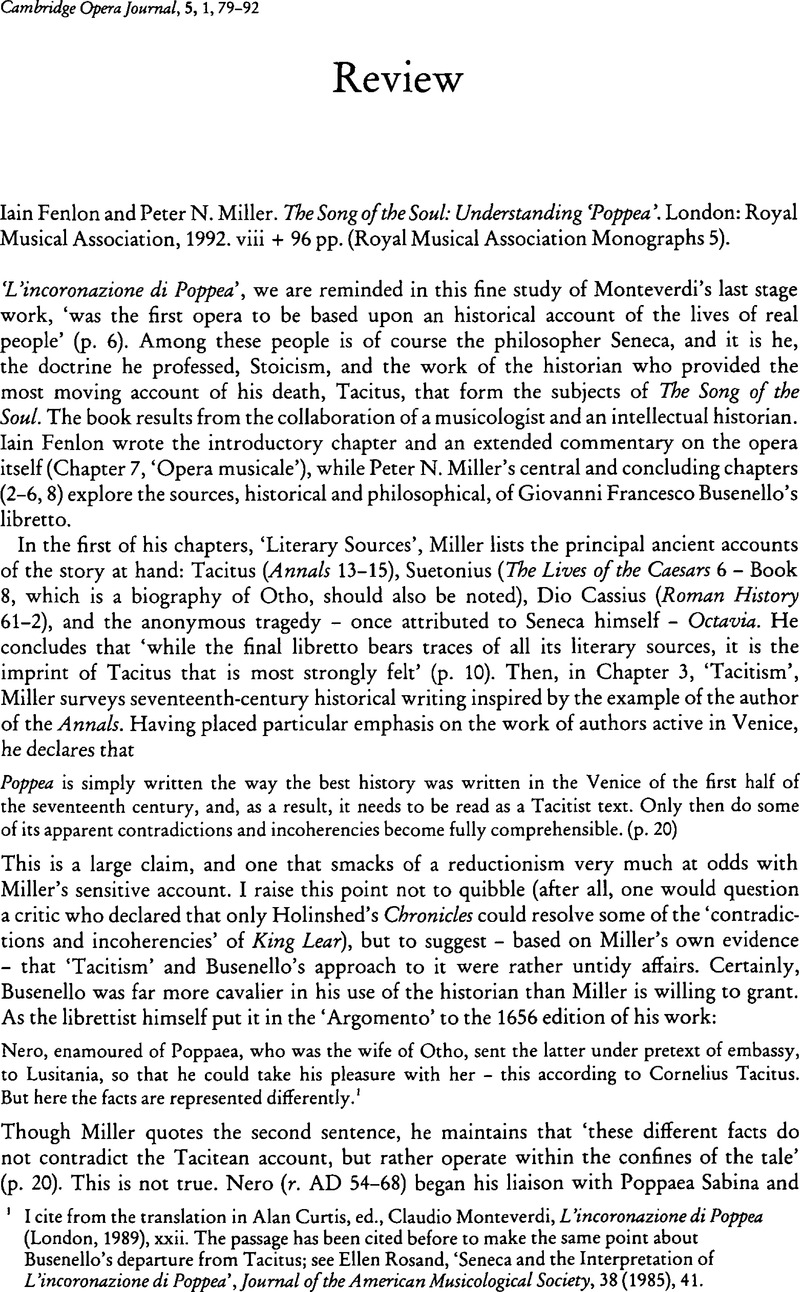Published online by Cambridge University Press: 27 August 2008

1 I cite from the translation in Curtis, Alan, ed., Monteverdi, Claudio, L'incoronazione di Poppea (London, 1989), xxii.Google Scholar The passage has been cited before to make the same point about Busenello's depanure from Tacitus; see Rosand, Ellen, ‘Seneca and the Interpretation of L'incoronazione di Poppea’, Journal of the American Musicological Society, 38 (1985), 41.CrossRefGoogle Scholar
2 Quoted in Rosand, Ellen, Opera in Seventeenth-Century Venice (Berkeley, 1991), 60.Google Scholar
3 Rosand, , 57.Google Scholar
4 See Curtis, , xxiii.Google Scholar
5 quote from the translation by Graves, Roben, 2nd edn (Harmondswonh, 1979).Google Scholar
6 quote throughout from the translation by Grant, Michael (Harmondsworth, 1989).Google Scholar
7 Prolusiones academicae (Rome, 1617)Google Scholar, quoted in Schellhase, Kenneth C., Tacitus in Renaissance Political Thought (Chicago, 1976), 150.Google Scholar
8 Quoted in Schellhase, , 125.Google Scholar
9 Malvezzi, , Discourses upon Cornelius Tacitus, trans. Baker, Richard (London, 1642)Google Scholar, sig. A5r (not A5v, as Miller has it on p. 12, n. 5). Miller also wrongly states that ‘the first use of Tacitus as political theory was in a republication of Francesco Guicciardini's epigrammatic Ricordi with an accompanying commentary based on Tacitus’ (pp. 11–12). That honour belongs to Bruni's, LeonardoLaudatio Florentine urbis (1403)Google Scholar; see Schellhase, , 16–23.Google Scholar
10 Malvezzi, , Discorsi sopra Cornelio Tacito (Venice, 1622)Google Scholar, sig. †††2–††††4r.
11 Malvezzi, sig. A5v.
12 ‘Nelle Republiche si trovano huomini di maggior vaglia the nelle Monarchie, poiche la concorenza de’ soggetti, the aspirano à Magistrati supremi, opera the chiascheduno procura di avanzar it Compagno di merito, per trapassarlo nella conquista della dignità.’ Traiano Boccalini, La bilancia politica, vol. 1: Osservazioni politiche sopra i sei libri degli Annali di Cornelio Tacito, 2nd edn (Castellana [Geneva], 1678), 508.Google Scholar On Boccalini's Tacitism see Schellhase, (n. 7), 146–9, 226–7.Google Scholar
13 The dedications are found in Firpo, Luigi, ed., Boccalini, Traiano, Ragguagli di Parnaso e scritti minori, 3 vols. (Bari, 1948), I, 3–4, II, 3–6.Google Scholar
14 ‘La ragion di stato prevalere alcune volte al merito delle vinù, e superare etiandio le stesse leggi della Giustitia.’ Loredano, Della bizzarrie academiche.… parte seconda (Bologna, 1646), 199.Google Scholar The passage is also cited in Bianconi, Lorenzo and Walker, Thomas, ‘Dalla Finta pazza alla Veremonda: Storie di febiarmonici’, Rivista italiana di musicologia, 10 (1975), 418n164.Google Scholar
15 ‘Monteverdi's Poetic Choices’, in Pirrotta, , Music and Culture in Italy from the Middle Ages to the Baroque (Cambridge, Mass., 1984), 316.CrossRefGoogle Scholar
16 The second point is made in Rosand, , ‘Seneca’ (see n. 1.), 39–40.Google Scholar
17 Seneca discussed apatheia in Epistulae morales 9.2; avoidance of pain is treated in Epistulae morales 66.
18 Another error: on p. 30 Miller mentions ‘the incorporation of the Epicurean concept of friendship’ in the Neostoic programme. However, in Epistulae morales 9.8 Seneca distinguished between his idea of friendship and that of Epicurus.
19 See Morford, Mark, Stoics and Neostoics: Rubens and the Circle of Lipsius (Princeton, 1991), 179.Google Scholar
20 See Morford, , 179.Google Scholar
21 See Morford, , 178.Google Scholar
22 ‘Invidiate dalla malignità de gli emoli.’ I quote from Degli scherzi geniali del Loredano parte prima (Venice, 1637), 234.Google Scholar
23 Busenello's use of Seneca is pointed out in Rosand, , Opera (see n. 2), 40n12.Google Scholar
24 Here I pan company with Rosand, , ‘Seneca’ (see n. 1), 41n18Google Scholar, who argues that ‘Busenello's characterizations seem in some ways closest to those of Dio Cassius’.
25 Here and throughout I quote the translation of Gummere, Richard M., Seneca, , Ad Lucilium Epistulae Morales, 3 vols. (Cambridge, Mass., 1917–1925).Google Scholar
26 For the dialogue I quote the translation of Basore, John W., Seneca, , Moral Essays, 3 vols. (Cambridge, Mass., 1928–35).Google Scholar
27 I quote the 1595 translation of Sir Stradling, John, Two Booker of Constancie Written in Latine by Justus Lipsius, ed. Kirk, Rudolf (New Brunswick, NJ, 1939).Google Scholar
28 ‘Theater, Sets, and Music in Monteverdi's Operas’, in Pirrotta, (see n. 15), 267.Google Scholar
29 Rosand, , ‘Seneca’ (see n. 1), 41n18, 46.Google Scholar
30 I thank Paul Ferrara of Queens College, who pointed out this contradiction to me.
31 Bouwsma, William J., in ‘The Two Faces of Humanism: Stoicism and Augustinianism in Renaissance Thought’, in A Usable Past: Essays in European Cultural History (Berkeley, 1990), 48.Google Scholar Miller and Fenlon do not cite this essay. On Calvin's point see also Morford, (n. 19), 160–1.Google Scholar
32 See Bianconi, Lorenzo, Seventeenth–Century Music, trans. Bryant, David (Cambridge, 1987), 101–4.CrossRefGoogle Scholar
33 On the latter point see Grant, (n. 6), xiii.Google Scholar